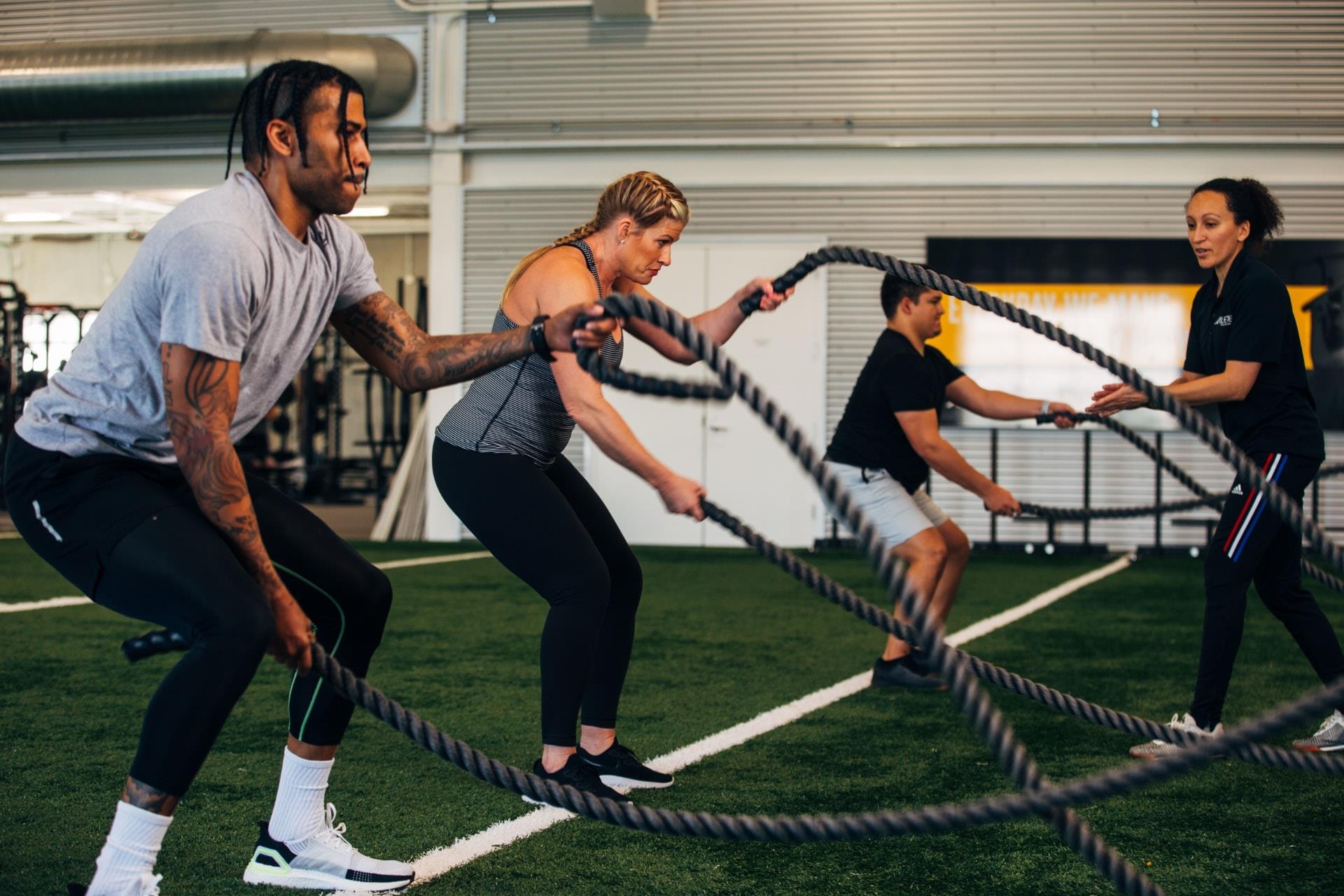Home>Misc>Featured>How Can Endurance Athletes Delay Muscle Fatigue During Training?


Featured
How Can Endurance Athletes Delay Muscle Fatigue During Training?
Modified: January 22, 2024
Discover the best strategies for featured endurance athletes to delay muscle fatigue during training and unlock peak performance.
Introduction
Endurance athletes, whether they are runners, cyclists, swimmers, or triathletes, constantly push the limits of their physical abilities in training and competition. The ability to sustain a high level of performance over an extended period of time is crucial for achieving success in endurance sports. However, one of the major challenges athletes face is muscle fatigue. This phenomenon can greatly impact athletic performance and hinder an athlete’s ability to maintain speed, power, and endurance.
Muscle fatigue is a complex physiological process that occurs when muscles are subjected to prolonged or intense exercise. It is characterized by a decrease in muscle force production, a decline in muscle power output, and an increase in perceived exertion. Muscle fatigue can be a limiting factor for endurance athletes, as it not only affects their ability to maintain intensity and speed but can also increase the risk of injury.
Understanding the causes and effects of muscle fatigue is essential for endurance athletes to develop effective strategies to delay its onset and minimize its impact. This article will explore these causes and effects in-depth, and provide valuable insights into how endurance athletes can best delay muscle fatigue during training.
Understanding Muscle Fatigue
Muscle fatigue is a complex physiological process that occurs when muscles are repeatedly activated and cannot generate the required force to sustain the exercise. It can be classified into two types: peripheral and central fatigue.
Peripheral fatigue occurs at the level of the muscles themselves. During prolonged exercise, the accumulation of metabolic byproducts, such as lactic acid, impairs muscle contraction and leads to a decrease in force production. Additionally, depletion of energy stores, such as glycogen, can contribute to peripheral fatigue. The recruitment of fast-twitch muscle fibers, which are responsible for generating higher force, can also deplete more quickly, leading to fatigue.
Central fatigue, on the other hand, originates in the central nervous system. It is believed to be caused by a decrease in the activation of motor units, which control the muscles’ contractions. Factors such as neurotransmitter depletion and changes in the neural drive from the brain to the muscles can contribute to central fatigue. Mental fatigue and psychological factors, such as motivation and perceived exertion, can also play a role in central fatigue.
Both peripheral and central fatigue can have a significant impact on athletic performance. When muscles become fatigued, they are less able to generate the force necessary for optimal performance. This can result in a decline in speed, power, and endurance, ultimately affecting an athlete’s ability to maintain a high level of performance over extended periods of time.
It is important for endurance athletes to understand the mechanisms behind muscle fatigue in order to develop effective strategies to delay its onset and reduce its impact. By addressing the underlying causes of fatigue, athletes can improve their performance and enhance their overall endurance abilities.
Causes of Muscle Fatigue
There are several factors that contribute to muscle fatigue in endurance athletes. Understanding these causes is key to developing effective strategies to delay its onset and minimize its impact.
One of the primary causes of muscle fatigue is the depletion of energy stores, particularly glycogen. Glycogen is the stored form of carbohydrates in the muscles and liver, and it serves as a critical fuel source during prolonged exercise. When glycogen levels become low, muscle contractions become weaker, leading to fatigue. Proper nutrition and adequate carbohydrate intake before, during, and after training sessions or competitions can help replenish glycogen stores and delay muscle fatigue.
Another factor that contributes to muscle fatigue is the accumulation of metabolic byproducts. During exercise, the muscles produce metabolites such as lactic acid, hydrogen ions, and reactive oxygen species. These byproducts can impair muscle function and contribute to the feeling of fatigue. Optimal hydration and electrolyte balance can help minimize the accumulation of these metabolites and delay muscle fatigue.
Additionally, the recruitment and fatigue of fast-twitch muscle fibers can contribute to muscle fatigue. Fast-twitch fibers are responsible for generating higher force and power, but they fatigue more quickly than slow-twitch fibers. Incorporating strength training exercises into an endurance athlete’s training routine can help improve the endurance capacity of these fast-twitch muscle fibers, delaying fatigue during endurance activities.
Mental fatigue and psychological factors also play a role in muscle fatigue. The perception of effort and motivation can impact an athlete’s ability to sustain a high level of performance. Strategies such as positive self-talk, mental imagery, and goal-setting can help athletes overcome mental fatigue and maintain focus and motivation during training or competitions.
Overall, a combination of factors including energy depletion, metabolite accumulation, muscle fiber fatigue, and mental fatigue contribute to muscle fatigue in endurance athletes. By addressing these causes with specific strategies, athletes can delay the onset of muscle fatigue and improve their endurance performance.
Effects of Muscle Fatigue on Endurance Performance
Muscle fatigue can have significant effects on an endurance athlete’s performance, affecting their ability to maintain speed, power, and endurance. Understanding these effects can help athletes develop strategies to mitigate their impact and improve overall performance.
One of the primary effects of muscle fatigue is a decrease in muscle force production. As muscles become fatigued, they are less able to generate the necessary force to maintain intensity and power output. This can result in a decline in speed and performance, making it more challenging for athletes to sustain a high level of effort.
In addition to decreased force production, muscle fatigue can also lead to a decline in muscle power output. Power, which is the combination of force and speed, is crucial for maintaining a strong and efficient stride or pedal stroke. When muscles fatigue, the power generated during each contraction diminishes, impacting an athlete’s ability to maintain optimal performance.
Another effect of muscle fatigue is an increase in perceived exertion. As fatigue sets in, the effort required to sustain a given intensity can feel more challenging. This can lead to a decrease in motivation and mental fatigue, making it harder for athletes to push through discomfort and maintain their performance.
Furthermore, muscle fatigue increases the risk of injury for endurance athletes. Fatigued muscles have reduced stability, coordination, and control, making them more susceptible to strains, sprains, and overuse injuries. This highlights the importance of delaying muscle fatigue to protect an athlete’s musculoskeletal health and minimize the risk of potential injuries.
Overall, the effects of muscle fatigue on endurance performance include decreased force production, reduced power output, increased perceived exertion, and an elevated risk of injury. By understanding these effects, endurance athletes can implement strategies to delay muscle fatigue and optimize their performance.
Strategies to Delay Muscle Fatigue in Endurance Athletes
Endurance athletes can employ various strategies to effectively delay muscle fatigue, enabling them to maintain their performance and endurance for longer periods of time. Implementing these strategies can help athletes achieve their training goals and excel in competitions.
Proper Nutrition and Hydration: Adequate nutrition and hydration are essential for delaying muscle fatigue. Consuming a well-balanced diet that includes sufficient carbohydrates, proteins, and fats provides the necessary fuel to sustain exercise. Additionally, staying properly hydrated helps maintain optimal muscle function and prevent the build-up of metabolites that contribute to fatigue.
Adequate Rest and Recovery: Rest and recovery play a critical role in delaying muscle fatigue. Endurance athletes should ensure they get enough sleep and allow their bodies time to recover between training sessions. Incorporating rest days and active recovery activities, such as stretching or foam rolling, can also help reduce muscle fatigue and enhance overall performance.
Incorporating Strength Training: Including strength training exercises in an endurance athlete’s training program can improve muscle strength, endurance, and delay fatigue. Strength training helps activate and strengthen the fast-twitch muscle fibers, allowing athletes to generate more force and power during endurance activities.
Utilizing Interval Training: Interval training involves alternating between high-intensity efforts and rest or recovery periods. This training method improves cardiovascular fitness and enhances the body’s ability to buffer lactate, reducing fatigue. Interval training also challenges the muscles to perform at high intensities, training them to delay fatigue during endurance activities.
Implementing Cross-training: Cross-training involves participating in different types of activities to enhance overall fitness and reduce the risk of overuse injuries. By engaging in activities such as swimming, cycling, or strength training, endurance athletes can give their primary muscles a break while maintaining cardiovascular fitness and working different muscle groups.
By incorporating these strategies into their training routine, endurance athletes can significantly delay the onset of muscle fatigue and improve their performance in endurance activities. Each athlete should customize their approach based on their specific goals, training level, and individual needs.
Proper Nutrition and Hydration
Nutrition and hydration play a crucial role in delaying muscle fatigue and optimizing performance for endurance athletes. Proper fueling and hydration strategies before, during, and after training or competitions are essential to maintain energy levels, support muscle function, and minimize the risk of dehydration.
Pre-Exercise Nutrition: Prior to a training session or competition, athletes should focus on consuming a balanced meal or snack that includes carbohydrates, proteins, and fats. Carbohydrates are especially important as they provide the primary fuel source for endurance activities. Optimal choices include whole grains, fruits, and vegetables. Including a moderate amount of protein helps support muscle repair and growth, while fats provide sustained energy. It’s best to eat a meal or snack about 1-3 hours before exercise to allow for digestion.
Hydration: Staying properly hydrated is vital for delaying muscle fatigue and maintaining performance. Dehydration can lead to decreased blood volume, reduced oxygen transport, and impaired thermoregulation. Athletes should aim to drink adequate fluids throughout the day and continue hydrating during exercise. The American College of Sports Medicine recommends drinking 16-20 ounces of fluid 4 hours before exercise, 8-12 ounces 10-15 minutes before exercise, and 5-10 ounces every 15-20 minutes during exercise.
During-Exercise Fueling: Endurance athletes participating in activities lasting longer than 60-90 minutes should consider fueling with carbohydrates during exercise. Consuming 30-60 grams of carbohydrates per hour can help maintain blood glucose levels and delay muscle fatigue. Sports drinks, gels, energy bars, or even real food options like bananas or dates can provide easily digestible carbohydrates for sustained energy.
Post-Exercise Recovery: Proper recovery nutrition is crucial to replenish energy stores and support muscle repair and growth. Consuming a combination of carbohydrates and protein within 30-60 minutes after exercise can optimize recovery. Aim for a 3:1 or 4:1 ratio of carbohydrates to protein, such as a smoothie with fruits and a scoop of protein powder, to promote muscle glycogen replenishment and protein synthesis.
Endurance athletes should also pay attention to individual factors like body weight, sweat rate, and environmental conditions to tailor their nutrition and hydration strategies accordingly. Working with a sports dietitian or nutritionist can provide personalized guidance to optimize fueling and hydration strategies for performance and delay muscle fatigue.
Adequate Rest and Recovery
Rest and recovery are crucial components in delaying muscle fatigue and optimizing performance for endurance athletes. Giving the body enough time to recover and repair itself after intense training sessions or competitions is essential for maintaining overall health, minimizing the risk of injury, and improving performance.
Physical Recovery: Adequate rest allows the muscles, tendons, and ligaments to repair and rebuild, reducing the risk of overuse injuries. Endurance athletes should schedule regular rest days within their training programs. These rest days help prevent excessive stress on the musculoskeletal system, allowing for recovery and adaptation to occur. Active recovery activities, such as gentle stretching, yoga, or foam rolling, can also aid in enhancing blood flow, promoting relaxation, and reducing muscle soreness.
Sleep: Quality sleep is essential for optimal recovery and performance. During sleep, the body repairs damaged tissues, releases growth hormone, and regulates important metabolic processes. Aim for 7-9 hours of uninterrupted sleep each night to maximize recovery. Establishing a consistent sleep routine and creating a sleep-friendly environment can help ensure sufficient rest.
Nutrition for Recovery: Proper nutrition plays a significant role in recovery. Consuming a balanced meal or snack that includes carbohydrates, proteins, and healthy fats can support muscle repair and replenish glycogen stores. Including protein-rich foods like lean meats, eggs, legumes, or dairy products promotes muscle repair and growth. Additionally, anti-inflammatory foods like fruits, vegetables, and omega-3 fatty acids can help reduce inflammation and facilitate recovery.
Mental Recovery: Rest and recovery extend beyond the physical aspect; mental recovery is equally important. Engaging in activities that promote relaxation and stress reduction, such as meditation, deep breathing exercises, or engaging in hobbies, can help athletes recharge mentally and emotionally. Taking breaks from training, setting realistic goals, and practicing self-care can contribute to improved mental well-being and long-term performance.
Remember that rest and recovery are not signs of weakness, but rather important components of a well-rounded training program. Neglecting adequate rest can lead to overtraining syndrome, decreased performance, and increased risk of injury. By prioritizing rest and recovery, endurance athletes can optimize their training adaptations, delay muscle fatigue, and promote overall performance and longevity in their athletic endeavors.
Incorporating Strength Training
Strength training is a valuable addition to the training regimen of endurance athletes. While endurance activities focus on cardiovascular fitness and aerobic capacity, strength training offers numerous benefits that can help delay muscle fatigue and enhance overall performance.
Improved Muscle Strength: Strength training exercises target specific muscle groups, enhancing their strength and endurance. By increasing muscle strength, endurance athletes can generate more force during their activities, which delays muscle fatigue and improves performance. Compound exercises such as squats, deadlifts, lunges, and resistance training with weights or resistance bands can effectively engage multiple muscles and improve overall strength.
Enhanced Running Economy: Strength training helps improve running economy, which refers to the energy cost of running at a given speed. By strengthening muscles and improving running mechanics, endurance athletes can maintain a more efficient running form, using less energy per stride. This improved efficiency translates to delayed muscle fatigue and extended endurance during training and competitions.
Increased Power Output: Strength training exercises, such as plyometrics or explosive movements, can improve power output. Power is essential in activities that require explosive movements, such as sprints, uphill climbs, or jumps. By increasing power, athletes can perform these movements with greater force and speed, delaying muscle fatigue and maintaining performance in these high-intensity efforts.
Injury Prevention: Incorporating strength training helps strengthen muscles, tendons, and ligaments, reducing the risk of overuse injuries. Strong muscles provide better support and stability to joints, reducing the impact of repetitive stress. Exercises that target stabilizer muscles, such as core exercises, can enhance overall body stability and reduce the risk of imbalances or compensatory movements that can lead to injuries.
Improved Muscular Endurance: Endurance athletes can benefit from increased muscular endurance gained through strength training. This type of training challenges the muscles to perform repetitive contractions over time, leading to improved endurance capacity. By delaying muscle fatigue, athletes can sustain a higher level of performance during long-duration activities like distance running or cycling.
It is essential for endurance athletes to integrate strength training exercises into their training program in a progressive and balanced manner. Working with a qualified strength and conditioning professional can ensure proper technique, appropriate exercise selection, and a well-structured program that aligns with an athlete’s specific goals and needs.
Utilizing Interval Training
Interval training is a popular and effective method for delaying muscle fatigue and improving endurance performance. It involves alternating between periods of high-intensity exercise and periods of rest or active recovery. This training approach has several benefits for endurance athletes.
Improved Cardiovascular Fitness: Interval training challenges the cardiovascular system by pushing the heart rate to higher levels during intense effort. This helps improve the body’s ability to transport oxygen to the working muscles, enhancing cardiovascular fitness and delaying muscle fatigue.
Lactate Threshold Training: Interval training can help athletes improve their lactate threshold, which is the exercise intensity at which lactate begins to accumulate in the muscles. By training at or near the lactate threshold, endurance athletes can increase the body’s ability to buffer lactate and endure higher intensities, delaying the onset of muscle fatigue.
Enhanced Speed and Power: Interval training, particularly high-intensity intervals, can improve an athlete’s speed and power output. By incorporating short bursts of maximum effort during training, endurance athletes can develop the explosive energy necessary to succeed in sprints, uphill climbs, or race finishes.
Time Efficiency: Interval training allows athletes to get a significant training stimulus in a shorter amount of time. By working at higher intensities for specific intervals, athletes can achieve the same or even greater physiological adaptations compared to longer-duration, steady-state training sessions.
Mental Resilience: Interval training challenges athletes mentally as well. The intense effort and shorter recovery periods push athletes out of their comfort zones, helping them develop mental toughness and resilience in the face of fatigue and discomfort.
When incorporating interval training into a training plan, it is essential to consider individual fitness level, goals, and the specific demands of the targeted endurance event. Working with a qualified coach or exercise professional can help athletes design an interval training program tailored to their needs.
Examples of interval training include high-intensity intervals on the track, hill repeats, tempo runs, or cycling intervals. The duration, intensity, and recovery intervals can be adjusted based on the athlete’s specific goals and training level.
Remember to gradually introduce and progress interval training to prevent overexertion and the risk of injury. It is recommended to warm up properly before starting intervals and always prioritize recovery and rest between interval sessions to allow for proper adaptation and muscle recovery.
Implementing Cross-training
Cross-training is a valuable strategy for endurance athletes to delay muscle fatigue and optimize performance. It involves participating in activities outside of the primary endurance sport to enhance overall fitness, prevent overuse injuries, and improve specific muscle groups.
Muscle Balance and Injury Prevention: Cross-training allows athletes to engage different muscle groups and movements, promoting muscle balance and reducing the risk of overuse injuries. By incorporating activities such as swimming, strength training, yoga, or cycling, athletes can strengthen supporting muscles, improve joint stability, and enhance overall musculoskeletal health.
Mental Refreshment: Engaging in different activities through cross-training can provide a mental break from the repetitive nature of endurance training. It can reignite motivation, prevent burnout, and contribute to a more well-rounded and enjoyable training experience.
Improved Cardiovascular Fitness and Recovery: Cross-training activities like swimming or cycling can provide alternative cardiovascular workouts. These activities can be less impactful on the joints while still maintaining or improving cardiovascular fitness. Incorporating low-impact cross-training exercises allows the muscles used in endurance activities to recover while still engaging the cardiovascular system.
Enhanced Strength and Power: Cross-training, particularly strength training, helps athletes develop greater overall strength and power. This can lead to improved performance in endurance activities, as stronger muscles are better equipped to delay fatigue and maintain optimal form and speed.
Enhanced Body Awareness and Coordination: Cross-training activities that require balance, agility, and different movement patterns can improve body awareness and coordination. This can translate into better control during endurance activities, reducing the risk of falls and improving overall efficiency.
The choice of cross-training activities should be based on an athlete’s individual needs, interests, and goals. It is important to choose activities that complement and support the primary endurance sport. For example, swimmers can benefit from incorporating strength training or cycling into their routine, while runners may find cross-training with yoga or Pilates beneficial for flexibility and core stability.
It is important to strike a balance between the primary endurance sport and cross-training activities. The frequency, intensity, and duration of cross-training exercises should be considered within the context of the overall training program. Consulting with a coach or exercise professional can help athletes design a well-rounded training plan that incorporates cross-training effectively.
Conclusion
Muscle fatigue is an inevitable challenge that endurance athletes face during training and competitions. However, by understanding the causes and effects of muscle fatigue, athletes can implement effective strategies to delay its onset and minimize its impact.
Proper nutrition and hydration play a critical role in sustaining energy levels and supporting muscle function. Adequate rest and recovery allow the body to repair and rebuild, reducing the risk of overuse injuries. Incorporating strength training exercises improves muscle strength, power, and endurance. Interval training challenges cardiovascular fitness and enhances the body’s ability to buffer lactate. Cross-training engages different muscle groups, prevents overuse injuries, and provides mental refreshment.
Each strategy discussed in this article contributes to delaying muscle fatigue and optimizing endurance performance. However, it is important for athletes to tailor their approach based on their specific goals, training level, and individual needs.
By implementing these strategies consistently and progressively, endurance athletes can improve their performance, delay muscle fatigue, and achieve their goals. It is important to remember that the journey to peak performance is a continuous process that requires dedication, perseverance, and proper planning. Embracing a well-rounded approach to training and incorporating these strategies will help athletes reach their full potential and excel in their endurance pursuits.









